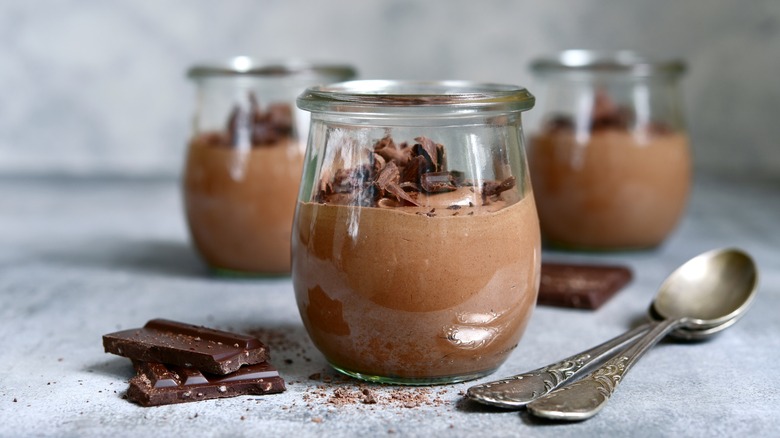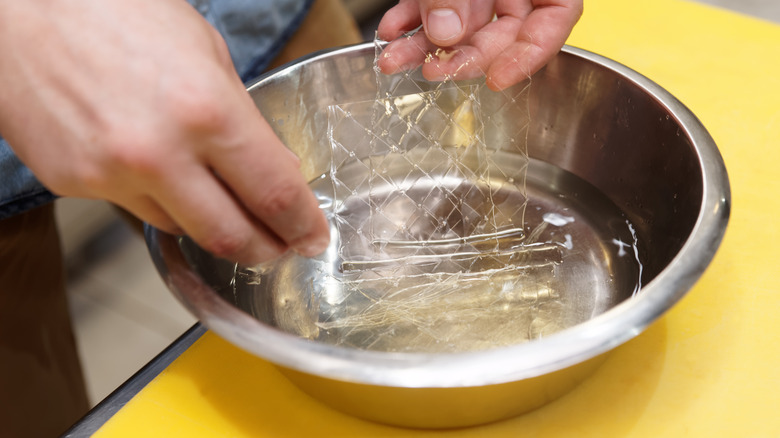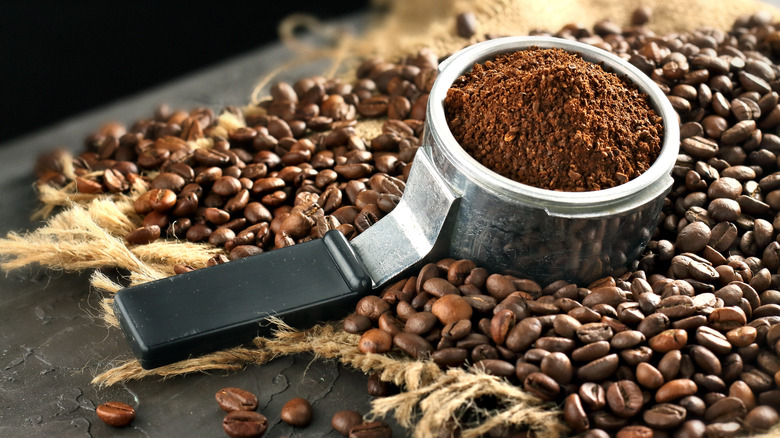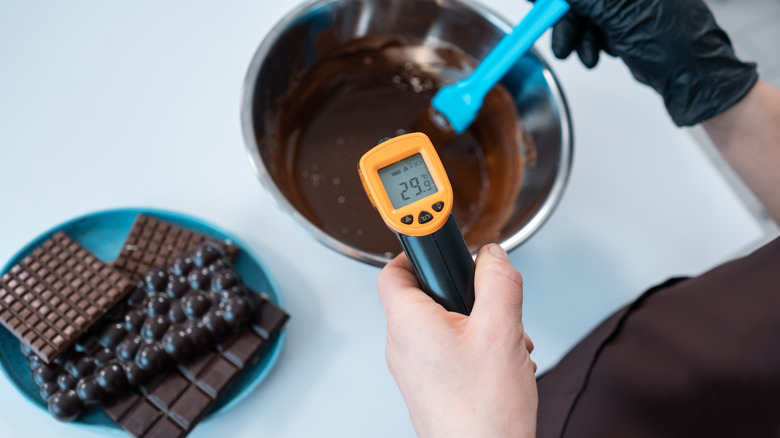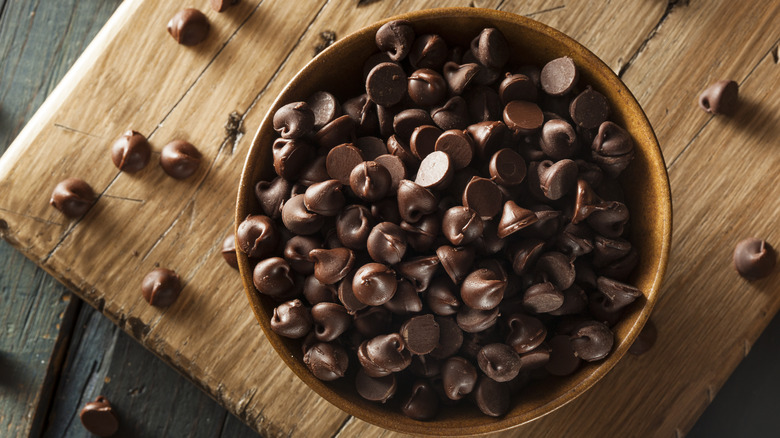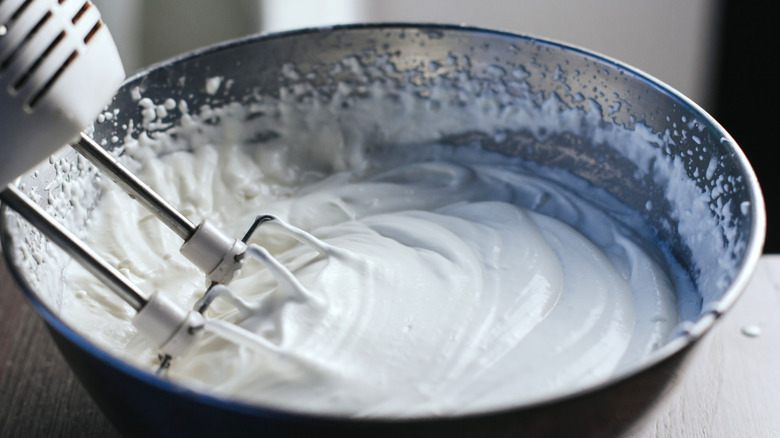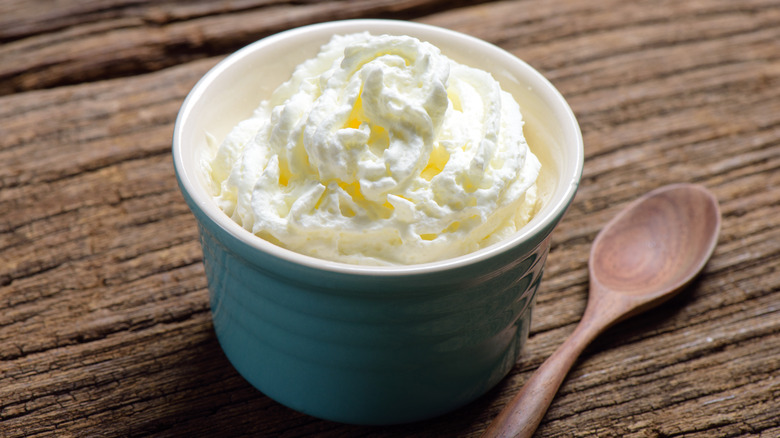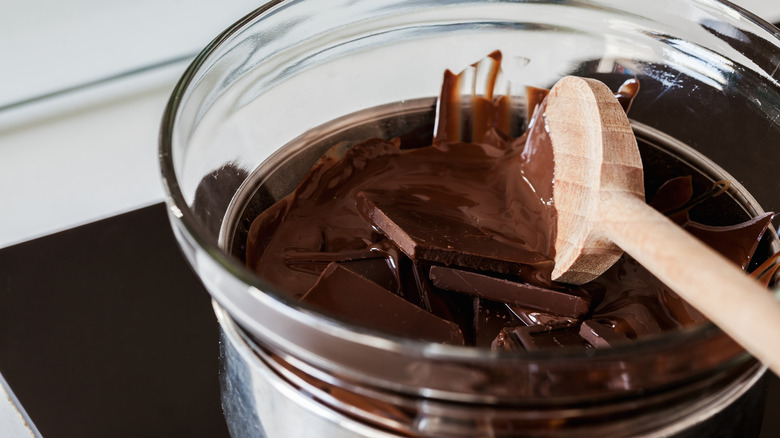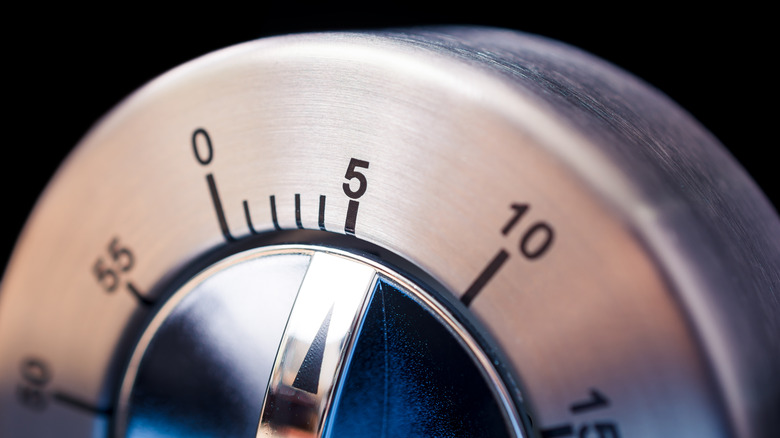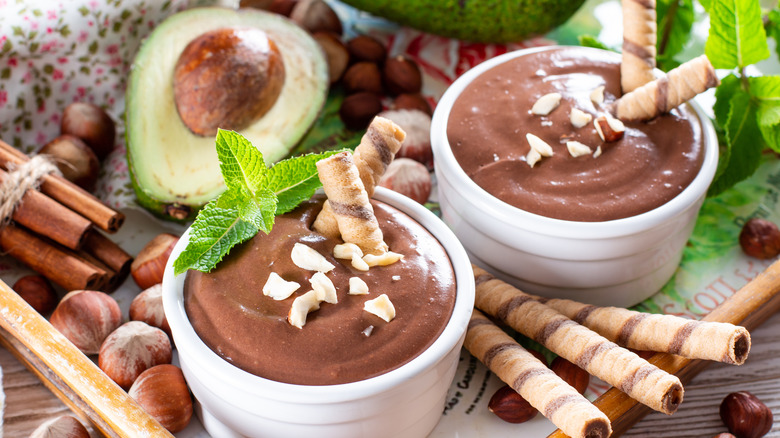Secrets For Making The Perfect Mousse
We may receive a commission on purchases made from links.
The word "mousse" literally translates to "foam" in French, which is as apt a term to describe this dessert as it can be. Our first foray into making a classic mousse au chocolat or chocolate mousse was when we were creating a Julia Child themed dinner. We carefully followed her detailed recipe as it appeared in the original "Mastering the Art of French Cooking." That recipe is incredibly detailed, somewhat complicated, and involves a rather elaborate list of ingredients. But...all of the fuss is worth it. What resulted was an incredibly light, fluffy, airy dessert perfect for an elegant meal.
And while Julia's recipe is foolproof, as she was fond of saying, it is hardly the only recipe out there for chocolate mousse. There are many, highlighting the myriad ways in which one can execute this delectable confection. Regardless of which recipe you choose, there are a number of factors that go into achieving exactly the right texture and flavor. Our goal is to illuminate some of the pitfalls and offer some tried and true tips to take the mystique out of crafting a dessert that is equal parts sophistication and simplicity. If you follow these guidelines, you are sure to manifest the quintessential mousse every time you set foot in the kitchen.
Try using gelatin
Classic French recipes for chocolate mousse often involve the use of raw eggs that are beaten to perfection to obtain a cloud-like texture and stabilize the dessert. However, per Healthline, the consumption of raw eggs can be ill-advised for certain populations due to the potential risk of contamination by Salmonella common in unpasteurized eggs. Young children, the elderly, pregnant women, and anyone living with an autoimmune system that is compromised should avoid them.
The solution for these individuals is to opt for a recipe using gelatin as a stabilizer (via MasterClass). You can utilize either gelatin sheets or powdered gelatin depending on what the recipe calls for or what you have available to you at your local grocery store. A general rule of thumb for gelatin is that for every sheet of gelatin you need, you can substitute it with 1 teaspoon of powdered gelatin dissolved in 1 tablespoon of cold water. In our experience, it may take a couple of tries to get the texture exactly correct when using gelatin. The exact ratio of gelatin to other ingredients may need to be fiddled with to achieve a mousse that is supple but still holds together. For this reason, powdered gelatin may be a better option in terms of controlling the gelatin percentage.
Add coffee
The concept of incorporating coffee into chocolate isn't a new one. Many chocolate recipes ranging from brownies to cakes to mousse call for a small quantity of coffee to be added. Something about the coffee accentuates the chocolate flavor without becoming overly coffee-flavored. It's almost like magic. If you don't believe us, try baking a recipe both ways — one with the coffee and one without. We have done it and we can tell you from first-hand experience that it makes a huge difference.
Most recipes will call for espresso powder, which is finely ground enough to easily blend into the batter without noticeable graininess. One tablespoon or so is enough to pop the chocolate flavor in almost any recipe. If you don't have espresso powder, there are a couple of options for substitutions. Where mousse is concerned, texture is tantamount, so our favorite swap-outs include a hint of instant coffee, or a teaspoon or two of cold brewed coffee. Be sure not to add too much of the brewed coffee as it can water down your recipe making it not set properly. While coffee grinds may be suitable for recipes that are baked, which allows for the heat and moisture to dissolve the grinds, they cannot be used for a mousse. Even if added to the melting chocolate it will not get hot enough or moist enough to break down.
Make sure your ingredients are at the right temperature
The importance of temperature in every step of the mousse-making process cannot be overstated. It is one of the single biggest factors to your mousse having a frothy and smooth texture or becoming a gritty, gooey mess. Egg whites must be at room temperature when beaten in order for proper aeration to occur while beating. In contrast, heavy cream must be cold when whipped, otherwise, it will not retain enough bubbles to become thickened. Pro tip: It helps to use a metal bowl — preferably copper or stainless steel — when whipping both egg whites and cream for the best quality foam to develop. And we recommend chilling your bowl prior to beating your cold whipped cream to maintain the temperature while beating.
When it comes to folding all of the ingredients together for the final mousse, having them at roughly the same temperature is critical. If your chocolate is still warm from melting it, it may dissolve the egg whites and whipped cream, thereby deflating them. Additionally, if the eggs and cream are too cold, they may shock the melted chocolate and cause it to seize up. And always make sure to serve your mousse straight out of the refrigerator to avoid the possibility of it melting, thereby destroying its foamy texture.
Use high-quality chocolate
Perhaps it goes without saying, but when chocolate is the star of the show — as it is in a chocolate mousse — this is not the time to skimp on the quality of chocolate you use. Save the discount chips you found on sale for cookies or to top off your bowl of vanilla ice cream. The particular brand you choose is less important than trusting your palate. You always want to use a chocolate you'd eat.
Moreover, the precise percentage of chocolate is less important than what type of chocolate the recipe calls for — namely bittersweet, semi-sweet, or milk. Each of these contains distinct quantities of sugar and dairy powder, making them behave uniquely. Therefore, you should never substitute one for the other if you want to ensure your dessert turns out with the correct texture. This is doubly important with something as fickle as mousse.
Bon Appetit also suggests opting for wafers of chocolate in recipes where the chocolate needs to be melted. They don't have any stabilizers in them and their uniform size helps them melt more evenly.
And finally, do not use chocolate that has been improperly stored. It is extremely susceptible to heat and moisture and any change in either of these can compromise its ability to melt properly. If your chocolate has developed a lighter cloudy spot on it which is called a "bloom," you can still use it as long as there are no other noticeable indications of spoilage to its structural integrity.
Don't whip your ingredients at high speeds
According to Valrhona, the key to creating a perfect mousse lies in the whipping process. Considering the name of this dessert, this is hardly surprising. And the secret to a perfectly light, airy meringue or whipped cream has to do with the speed at which you have your mixer set. When you attempt to whip either egg whites or cream at very high speeds, you create large bubbles, which do not have the integrity to uphold their shape. When you beat them at a more moderate speed, smaller bubbles will accumulate and bind together, creating a tight network of interlocking bubbles that will withstand not just the process of folding all the ingredients together for your mousse but will also keep in the refrigeration process without deflating.
Additionally, where whipping cream is concerned, the perfect whip will amplify the volume of the cream by 220%. If you beat it any farther than that, you will begin to destroy the aeration and the volume of the cream will begin to contract, eventually resulting in butter. Whether you utilize a hand mixer or a stand mixer, start at a lower mixing speed and keep a close eye on the beating process to insure that you are not over-mixing your egg whites and whipping cream.
Don't use light whipping cream instead of heavy whipping cream
If you've ever gone to the grocery store and perused the dairy aisle, you may have noticed that cream often comes in a number of formats, including light whipping cream and heavy whipping cream. While it may seem like a good idea to opt for the light whipping cream to save on a few calories, this is ill-advised when the point of using the cream is to make whipped cream or ice cream (via Martha Stewart).
Heavy whipping cream has a milk fat content of 36% or higher. Light whipping cream typically has a milk fat content ranging between 30% and 35%. While this may not seem like a huge difference, when fluffiness is the name of the game, it's a game changer. The light whipping cream simply will not retain the volume that is necessary to create the foamy texture of a perfect mousse. Save those few calories elsewhere where the quality of the final dish won't be adversely compromised.
Be careful with how you melt your chocolate
If there's a key to making a great chocolate mousse, it's in how you melt your chocolate. Chocolate can be notoriously persnickety when it comes to melting. It very easily seizes when heated too rapidly, meaning it becomes clumpy and coagulated. Once this occurs, it's virtually impossible to salvage the chocolate, particularly if you need to fold it into egg whites and whipped cream.
The ideal way to melt chocolate is to use low heat. This can be done in one of two ways, either in the microwave or stovetop using a double boiler. If you plan to use a microwave, place your chocolate into a glass bowl. Slowly melt in increments, setting your microwave on a medium setting for a few seconds at a time until you begin to notice it starting to melt. Whisk occasionally during this process to ensure that you are melting the chocolate evenly.
To melt your chocolate via the stovetop, fill a small saucepan about ⅓ full with water and bring that water to a simmer. Place your chocolate in a glass bowl and then transfer the bowl to the top of the saucepan. The indirect heat from the steam will slowly begin to gently melt the chocolate. Be sure to whisk the chocolate consistently in order to melt it thoroughly. Regardless of which method you use, don't add any liquid to the chocolate until it has melted otherwise you may impede the melting process.
Don't rush the process
We don't know who said it first, but there's a quote that goes something like "you can't rush a good thing." While this may pertain to relationships, in the case of making a perfect chocolate mousse, it's equally applicable. Baking (and dessert making) is a scientific endeavor, and therefore takes time and effort. There are no shortcuts and there is no way to speed up the process without jeopardizing the finished product.
According to Mary Berry of BBC Good Food, when baking you should factor in an extra 25% of time to accommodate any idiosyncrasies in things like oven temperature, weather, or ingredients. While she may be referring to baking a cake, this is no less important when making any kind of dessert. The oddest circumstances may interfere with the way things come together. Everything from the freshness of your eggs and cream to the humidity may cause your recipe to take a slight bit longer to assemble or prepare. That doesn't mean you have done anything wrong, it's just one of the things about baking and creating desserts that make the process both frustrating and humbling at times. Like cultivating a relationship, your patience will be rewarded when you take time with your chocolate mousse.
Follow the recipe exactly
Cooking is an art, baking is a science. How many times have we heard that one? And yet, there is some truth to it as this is one of the most common problems people run into when baking. You cannot just eyeball your measurements. This is a recipe for disaster — pun intended. Unlike a chemistry class experiment where you might actually blow up the lab, you may not cause your kitchen to explode by ignoring measurements, but you most certainly will implode your final product.
Recipes for desserts are very carefully crafted with specific ingredients in distinct quantities added in precisely the correct order. If you skip any one of the steps or attempt to substitute ingredients, you are sure to fail at recreating the recipe successfully. Let us be the cautionary tale here. When we attempted to make Julia Child's Mousse au Chocolat recipe the second time, we thought we'd be cheeky and try to beat the ingredients for a shorter period of time at a higher speed than she suggests. We didn't think that extra minute would make a huge difference in the final product, but we were mistaken. The mousse was nowhere near as light and airy, and frankly, we wasted some very expensive chocolate and rum by thinking we could take a shortcut. Lesson learned. Don't be like us — be like Julia.
Try using an avocado for a vegan mousse
The avocado is experiencing a bit of a moment in the limelight of late. Between recipes for avocado toast, guacamole, and vegan desserts, the utility of this fruit in creating a creamy texture cannot be overstated. Don't believe us? Give it a try. We found that when perfectly ripe avocados are pureed and added to baked goods, they can be almost as convincing as using real butter or cream, less a bit of the airy lightness that you get from the real deal.
The key is to determine how much avocado to substitute in a recipe. For something like a mousse, you may need more than you think to achieve the desired creamy texture. You can start by adding one and go from there — a little at a time — until you get the perfect proportion. As a bonus, by adding avocado you are turning your dessert into a nutritional powerhouse, infusing loads of monounsaturated fats, potassium, fiber, and carotenoids (via Harvard T.H. Chan School of Public Health). Finally, a guilt-free dessert that everyone is sure to enjoy.
